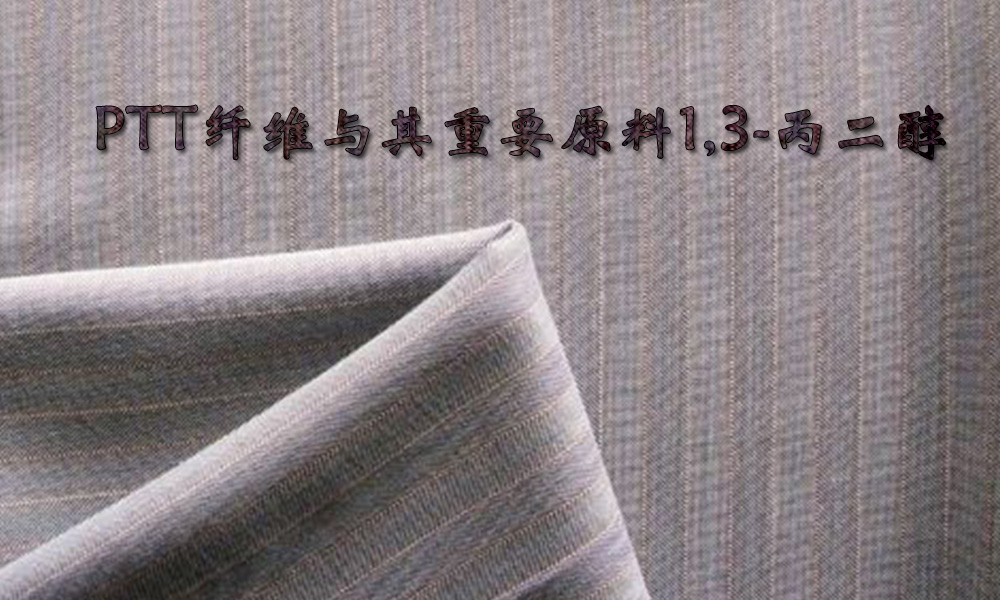
1,3-Propanediol It is also an important monomer raw material for manufacturing new polyester fiber polytrimethylene terephthalate (PTT) with excellent performance. The following supplier of propylene glycol will take you to learn about PTT fiber and 1,3- propylene glycol.
1. Introduction to PTT fiber:
PTT fiber is a new type of polyester fiber with excellent performance developed by Shell Company. It is made of polycondensation of terephthalic acid (PTA) and 1,3-propanediol (PDO). Its molecular structural formula is (( CH2)3OO=CO=CO))PTT fiber combines the softness of nylon, the fluffiness of acrylic fiber, the stain resistance of polyester, its inherent elasticity, and the ability to be dyed at room temperature. It combines the excellent properties of various fibers. With its integrated performance, it has become one of the latest popular new polymer materials developed in the world.
PTT fiber belongs to the same category as PET (polyethylene terephthalate) fiber and PBT (polybutylene terephthalate) fiber. Polyester. PTT fiber has the characteristics of polyester, nylon, and acrylic fiber. In addition to good anti-fouling properties, it is easy to dye, soft to the touch, and elastic. Its elongation is as good as spandex fiber. Compared with elastic fiber spandex, it is easier to process. It is very Suitable for textile and clothing fabrics; in addition, PTT also has the characteristics of dryness and crispness.
The specific characteristics are as follows:
1. PTT fabric is soft and has excellent drape. sex.
2. PTT fabric has comfortable elasticity (better than polyester PET, polybutylene terephthalate PBT and polypropylene PP fiber, and nylon 6 or nylon 66 fiber equivalent). The macromolecule odd carbon structure of PTT determines that the fiber has high elasticity and good elastic recovery rate. As far as tensile fibers are concerned, the relative breaking strength of PTT fiber is 20% to 30% lower than that of PET (polyester).
3. PTT fabric has excellent elongation recovery (it can still restore its original length after being stretched by 20%). When stretched by 20%, the acute elastic recovery rate of PTT fiber can reach 82%. After being held for 15 minutes, its elongation deformation returns to almost zero, and the total elastic recovery rate reaches almost 100%, while the total elastic recovery rate of PA, PBT, and PET fibers They are 80%, 70% and 44% respectively. Even after ten stretching cycles, PTT fiber still shows excellent resilience, which is not only higher than polyamide fiber (nylon) but also higher than other polyester fibers.
4. PTT has excellent dyeing and printing properties (general disperse dyes can be dyed at 98℃-110℃); excellent color fastness and light fastness strength and stain resistance. Because the glass transition temperature of PTT fiber is 50~55℃, it can be boiled and dyed at normal pressure without a carrier. At the same time, at the same dyeing temperature, the penetration depth of dyes in PTT is significantly higher than that of PET, and the color is uniform and the fastness is high. Fabrics blended with protein fibers such as wool and silk can be dyed in one step using a co-bath method.
5. PTT fabric has bright colors and is easy to iron.
6. PTT has a wide range of adaptability. PTT is suitable for pure spinning or compounding with cellulose fibers, natural fibers, and synthetic fibers to produce carpets, casual clothes, fashionable clothes, underwear, sportswear, swimwear and socks. It can also be used in curtains, bed cushions, mosquito nets, sofa covers, tablecloths, etc. In surface decorations such as toys and automobile interior decoration.
Introduction to 1,3-propanediol:
It is understood: Propylene glycol is divided into 1,2-propanediol and 1 , there are two types of 3-propanediol. The propylene glycol generally mentioned on the market is 1,2-propanediol, with CAS identification number 57-55-6. It is a chemical reagent, miscible with water, ethanol and various organic solvents. Its chemical formula is C3H8O2. Under normal conditions, it is a colorless, viscous liquid, almost odorless, and smells slightly sweet. Propylene glycol can be used as a raw material for unsaturated polyester resin. It can be used as a wetting agent in combination with glycerin or sorbitol in cosmetics, toothpaste and soap. It is used as a moisturizing and leveling agent in hair dyes, as an antifreeze, and in cellophane, plasticizer and pharmaceutical industries.
1,3-propanediol (1,3-PDO) is a colorless, odorless, salty, hygroscopic viscous liquid. It is a raw material for the production of unsaturated polyester, plasticizers, surfactants, emulsifiers and demulsifiers; in the polyurethane industry, it is commonly used as a raw material for polyester polyols, a starter for polyether polyols and a polyurethane extender. Chain agent, etc.; in the organic chemical industry, it is also an important monomer and intermediate. Its main use is as a polymer monomer to synthesize polytrimethylene terephthalate (PrT). It is widely used as an organic solvent in industrial production. It can be used in the synthesis of a variety of drugs, new polyester PTT, pharmaceutical intermediates and new antioxidants.



 微信扫一扫打赏
微信扫一扫打赏
